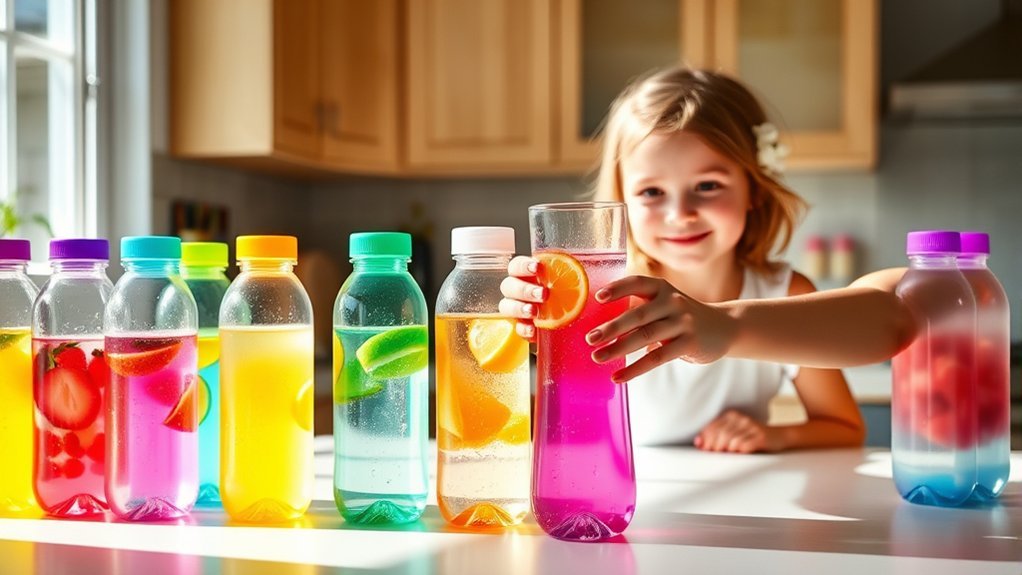As a parent, ensuring your child stays properly hydrated is essential for their growth and development. Daily fluid intake varies by age and activity, and it’s important to monitor both water consumption and signs of dehydration. By understanding these needs, you can create a structured hydration plan that encourages healthy habits. Discover the impact of hydration on your child’s well-being and learn effective strategies to make drinking water more engaging.
Understanding Hydration Needs for Children and Adults
When it comes to hydration, understanding the needs of both children and adults is vital for overall health.
Adults generally require about 2.7 liters for women and 3.7 liters for men each day, while children need varying amounts based on age, activity level, and climate.
For instance, toddlers may need around 1.3 liters, while older children might require 1.5 to 2.1 liters.
It’s important to monitor fluid intake, especially during hot weather or physical activities. Encourage water consumption as the primary source of hydration, and limit sugary drinks.
Remember, signs of dehydration can include fatigue, dizziness, or dark urine.
The Impact of Proper Hydration on Child Development
Proper hydration plays an essential role in your child’s development, influencing everything from cognitive function to physical growth. When your child is well-hydrated, their brain operates at peak efficiency, improving focus and learning abilities. In addition, adequate hydration supports physical performance, enhancing endurance and reducing the risk of injuries.
| Aspect of Development | Impact of Hydration | Evidence Source |
|---|---|---|
| Cognitive Function | Better focus and memory | Journal of Nutrition |
| Physical Growth | Improved muscle function | Pediatrics Journal |
| Mood Regulation | Enhanced emotional stability | Child Development Research |
| Immune Function | Stronger disease resistance | American Academy of Pediatrics |
| Overall Health | Reduced fatigue and lethargy | Nutrition Reviews |
Encouraging proper hydration can greatly support your child’s overall development.
Fun Ways to Encourage Kids to Drink More Water
Keeping your child hydrated is essential, but it can sometimes be a challenge to get them to drink enough water. One fun way is to create a colorful water station at home, using various fruits to infuse their water. Let them choose their favorite combinations, making it a fun, interactive activity.
You can also invest in a water bottle with fun designs or characters they love, encouraging them to carry it everywhere. Another idea is to set up a hydration challenge, rewarding them for reaching daily water goals.
Finally, incorporate water breaks during playtime or family activities, turning it into a routine. By making hydration enjoyable, you’ll help them develop healthy drinking habits for life.
Recognizing Signs of Dehydration in Your Family
How can you tell if your family is getting enough hydration? Recognizing signs of dehydration is essential. Look out for these common indicators:
| Sign of Dehydration | Mild Symptoms | Severe Symptoms |
|---|---|---|
| Thirst | Dry mouth | Rapid heartbeat |
| Urine color | Dark yellow | Confusion |
| Fatigue | Dizziness | Fainting |
| Skin elasticity | Slightly dry skin | Very dry skin |
If you notice any of these signs, encourage your family to drink water immediately. For children, watch for changes in mood or activity levels, as they often won’t voice their thirst. Staying vigilant can help you keep your family properly hydrated and healthy.
Creating a Family Hydration Plan for Daily Success
While ensuring your family stays hydrated may seem straightforward, creating a structured hydration plan can make a significant difference in their overall health.
Start by setting daily water intake goals tailored to each family member’s age and activity level. Use reusable water bottles to encourage regular sipping throughout the day.
Schedule hydration breaks during meals, snacks, and activities, reminding everyone to drink up. Incorporate hydrating foods like fruits and vegetables into meals to boost overall fluid intake.
Make it fun—try flavored water or hydration challenges to keep everyone engaged.
Finally, monitor progress and adjust the plan as needed. With these steps, you’ll help your family develop healthy hydration habits that last a lifetime.
Frequently Asked Questions
How Much Water Should Infants Under One Year Drink Daily?
Infants under one year usually get enough hydration from breast milk or formula. If you’re introducing solids, you can offer a few ounces of water daily, but always consult your pediatrician for personalized advice.
Can Sugary Drinks Count Towards Hydration Goals?
While sugary drinks might seem like a sweet solution for hydration, they often lead to more thirst and health issues. Stick to water and milk for your little one’s hydration—it’s the healthier choice.
What Are the Best Hydration Options for Active Kids?
Water’s your best bet for active kids, but low-sugar sports drinks can help replenish electrolytes after intense activities. Encourage them to sip water regularly throughout the day to stay properly hydrated and energized.
How Does Climate Affect Hydration Needs for Children?
Climate’s like a thermostat for hydration needs; hotter weather increases sweat loss, so kids need more fluids. In humid conditions, they may not feel thirsty, but their bodies still require adequate hydration to stay healthy and active.
Are There Specific Hydration Tips for Children With Special Needs?
Yes, encourage frequent sips throughout the day, offer flavored water, and monitor their intake. Use visual aids to remind them. Keep an eye on signs of dehydration, adjusting hydration strategies based on their specific needs.
Conclusion
Incorporating hydration into your family’s daily routine can be as simple as planting a garden. Just as a plant needs water to thrive, your children need proper hydration for ideal growth and development. Remember, studies show that even mild dehydration can impair cognitive function in kids. By prioritizing water intake and making it fun, you’re nurturing their potential. So, fill those water bottles and watch your little ones bloom—healthy, hydrated, and ready to take on the world!
